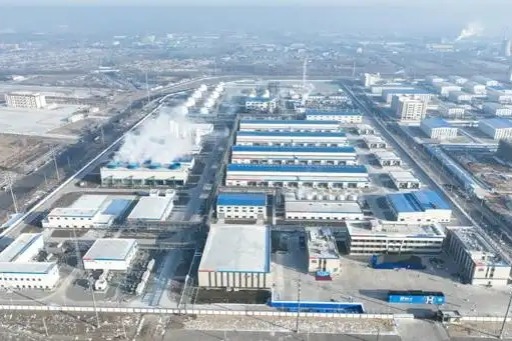From banking booms to hotel rooms
Formerly a financial center and then a resources-reliant province, Shanxi has found new sources of wealth

TAIYUAN-Once a deserted silk shop, the Xinglongyi Inn in Pingyao, Shanxi province, is now one of many centuries-old buildings taking advantage of the city's UNESCO heritage listing.
The inn has a 4.5 ranking on Trip-Advisor, the world's leading travel platform, and attracts hundreds of foreign visitors every year.
"From this house, my ancestors developed the tea trade with businesspeople from as far away as Russia in the Qing Dynasty (1644-1911)," said Zhao Xiaohong, owner of the inn. "But the locals seldom saw foreigners here in the old days. Nowadays, half of my guests are from Europe."
When she inherited the building it was dilapidated, but she restored it to keep the original exterior and turned the interior into hotel rooms.
Bart Johannes, a hotel guest from the Netherlands, said: "The buildings are well protected. The hostess is nice and can speak English. Best of all is the courtyard, a perfect place for drinking tea and reading."
Pingyao, an ancient walled city famed for its economic history, was named a world heritage by UNESCO in 1997.
Banking center
The city put itself on the map in the 19th century as China's financial center. Banks flourished as Shanxi merchants expanded their businesses across the country and abroad.
"In its heyday, Pingyao hosted 22 bank centers with outlets set up in 69 cities and townships nationwide. They controlled nearly half of the money in the country," said Gao Chunping, a researcher with the Shanxi Academy of Social Sciences.
Gao said many visitors asked why the prototype of China's banking system had mushroomed in the landlocked hinterland. He said because of its barren, remote location, the locals developed trade and finance to earn a living.
But Pingyao's golden days as a hub of trade and finance did not last. In the early 20th century, the banks collapsed like dominoes as the Qing Empire crumbled. There was an influx of foreign banks and later the country fell into war.
Despite the twists and turns, Shanxi's financial sector helped lay the foundation for China's banking system. The province witnessed the establishment of two forerunners of China's central bank during the War of Resistance Against Japanese Aggression (1931-45).
With the two banks, the Communist Party of China was able to issue currency in the 1940s before the founding of New China in 1949. The banks later merged to become the People's Bank of China.
But it was Shanxi's rich coal resources that had a more profound impact on national development.
Since the founding of the People's Republic of China, the province has produced more than 19 billion metric tons of raw coal and sent it to 26 Chinese provinces, autonomous regions, and municipalities to fuel local economic development.
Last year, Shanxi's raw coal output was 893 million tons, more than 340 times the output in 1949.
However, the fast growth has left scars on the landscape. Coal mining in the province seriously reduced the coverage of vegetation and worsened pollution. At least 3,000 square kilometers of land in Shanxi subsided as a result of coal mining, which also disrupted groundwater supplies.
New model
Shanxi was forced to change its economic development model. In 2009, the provincial government launched an energy revolution to reverse the chaos of coal mining and transition to green development.
The province closed 88 coal mines and from 2016 to last year cut 88.41 million tons of overcapacity, leading the country in reducing coal reliance.
Last year, the provincial government spent more than 400 billion yuan ($56 billion), 80 percent of its fiscal expenditure, on environmental protection, education, poverty alleviation and transportation.
Wang Ping is one of the workers directly affected by the changes. She was laid off in 2016 when the Shigejie Coal Mine was shut down.
The mine, one of China's largest coal producers during the 1960s, had operated for more than 90 years and had over 2,800 employees when it closed.
Lu'an Group, the owner of the coal mine, transferred Wang to work at Shanxi Lu'an Shigejie Zhihua Biotechnology which is owned by the group.
At first she was reluctant to go as her family had all worked in the coal mine. But soon she noticed the benefits of working at the new company.
"The company develops food and cosmetics with peony seed oil. I work in a packing factory. The environment is so clean, which is in big contrast to the mine shaft, and my monthly income increased by nearly 1,000 yuan," she said.
The biotechnology company now boasts one of China's largest seed oil production capacities, with a peony-planting base of 20,000 hectares.
Fresh opportunities
Over the past 20 years, the local government and leading enterprises like Lu'an have initiated programs to help farmers earn a living in mountain areas, while restoring the environment.
Farmers have responded by turning 1.82 million hectares of reclaimed land into forests, putting a "green coat" on the barren hills.
Sun Ping'er, 59, from Mengjiaping village in Xingxian county on the Loess Plateau, said locals traditionally lived in cave dwellings dug in slopes, which were humid, dark, and dangerous inside. "When I was young, our family of five lived in such a cave house. We only had two meals a day in winter," he said.
Two years ago, Sun and his wife joined a rural cooperative specializing in afforestation work to help alleviate poverty. They earned more than 50,000 yuan last year by planting high-value fruit trees, which not only lifted him out of poverty but also enabled him to enlarge and consolidate his cave dwelling with bricks and concrete. The refurbishment has made the cave dwelling spacious and safe. He spent 10,000 yuan on the building, which he could not have afforded 10 years ago.
By October, 41 counties in Shanxi had been lifted out of poverty.

Today's Top News
- China warns about Japan's intended military buildup
- China urges EU to halt anti-subsidy probes
- Experts: Lai not freedom fighter, but a pawn of the West
- Hainan evolves as gateway to global markets
- Opening up a new bridge between China and world
- Tour gives China-Arab strategic trust a boost






























